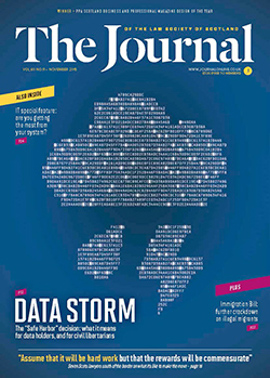Harassment: a civil claim?
The law has become increasingly specialised, but in certain areas different legal disciplines often overlap. Harassment can involve consideration of family law, crime, employment law and personal injury, depending on the circumstances. This article will focus on the remedies available to victims from the perspective of personal injury. It will discuss developments in the law and highlight some issues in recovering compensation.
You may be consulted by someone being harassed by a co-worker, an ex-partner, a current spouse, or even a neighbour. You maybe discussing non-harassment orders, interdicts or a claim for unfair dismissal. Your client may be seeking your advice as a family law or employment expert. You should, however, bear in mind that there may be a possibility of a claim in damages for harassment and advise the client accordingly.
Protection from Harassment Act 1997
This Act will generally be the focus of personal injury solicitors involved in harassment claims. It complements the common law. Different sections apply to different parts of the United Kingdom.
In Scotland, the victim can seek damages on the basis set out in s 8, under which “a person must not pursue a course of conduct which amounts to harassment of another and– (a) is intended to amount to harassment of that person; or (b) occurs in circumstances where it would appear to a reasonable person that it would amount to harassment of that person”. “Harassment” of a person includes causing the person alarm or distress; and a course of conduct must involve conduct on at least two occasions.
Domestic abuse
Since July 2011, no “course of conduct” is required if the pursuer was the victim of “conduct” which would be considered domestic abuse under s 8A of the Act, inserted by the Domestic Abuse (Scotland) Act 2011. In this case a person has only to present evidence of one occasion of harassing conduct before a claim of harassment will be successful. There is no need to show that conduct has taken place repeatedly.
What constitutes “domestic abuse”? The Act provides no definition.
Police Scotland works to a definition which was adopted by the former Association of Chief Police Officers in Scotland and the Crown Office & Procurator Fiscal Service. That is: “Any form of physical, sexual or mental and emotional abuse which might amount to criminal conduct and which takes place within the context of a relationship.
“The relationship will be between partners (married, cohabiting, civil partnership or otherwise) or ex-partners. The abuse can be committed in the home or elsewhere.”
Recoverable damages?
As with any claim, there may be an issue with recovery of damages if the perpetrator is a man of straw.
If the perpetrator is a person with assets there would be no difficulty. Equally, if the harassment took place in the workplace, the claim may be directed against the perpetrator’s employer.
The leading case is Majrowski v Guys & St Thomas’ NHS Trust [2007] 1 AC 224. The House of Lords held that an employer could be vicariously liable in damages under the 1997 Act for a course of conduct by one of its employees that amounted to harassment – but only if the conduct was closely connected with the acts the employee was authorised to do and might fairly and properly be regarded as done by the employee in the course of their employment.
Criminal Injuries Compensation
There is a further possibility of compensation through the Criminal Injuries Compensation Authority Scheme 2012 for victims of crimes of violence. This includes physical and sexual assault, and also includes a threat against a person causing fear of immediate violence, in circumstances which would cause a person of reasonable firmness to be put in such fear. However, it is essential that the incident(s) are reported to the police as soon as reasonably practicable. Normally, this would mean immediately following the incident. If there has been a delay, this must be explained to the Authority, who will assess whether it could have been reasonably practicable for the injured person to have reported the case sooner. There is also a prohibition on payment where there is a possibility that the perpetrator may benefit.
From this you will see that there a number of remedies available for a victim of harassment to claim damages. They are not without challenge, but should be explored with any client who has been harassed in any context.
In this issue
- Appropriate adults and defence agents: who does what?
- Buying from a housing association: why consent matters
- Harassment: a civil claim?
- A welcome abroad: EYBA in London
- Reading for pleasure
- Opinion: David Faith
- Book reviews
- Profile
- President's column
- ScotLIS gets the green light
- People on the move
- Storm over Safe Harbor
- Light on a murky world
- Southern horizons
- Mediation minefield
- Migrants: no way to turn?
- The technological edge
- As our suppliers see us
- More rules to grapple with
- Fraud and divorce – a Scottish Sharland?
- What future for employment tribunal fees?
- Heading for a showdown on hard won human rights?
- Taxing question of relief
- Scottish Solicitors Discipline Tribunal
- How far can we rely on the register?
- All part of the game
- Law reform roundup
- From the Brussels office
- Poverty: a new front in the war
- Damage limitation: working it out
- Ask Ash
- A lawyer's lament
- Appreciation: Michael Scanlan






